Nursing Objectives: Clinical Skills, ECG, and Medication Guidelines
VerifiedAdded on 2023/05/30
|13
|1994
|373
Practical Assignment
AI Summary
This nursing assignment outlines four key objectives aligned with the Nursing and Midwifery Board of Australia (NMBA) standards. The first objective focuses on chest pain management, emphasizing the importance of health assessment, diagnostic procedures like ECG and X-rays, and appropriate medical interventions, including medication and, in severe cases, surgical procedures. The second objective addresses the management of trans-radial bands post-procedure, highlighting potential complications and the importance of following clinical guidelines to minimize risks. The third objective covers the electrocardiograph (ECG) procedure, including lead placement and the use of the Angle of Louis method, emphasizing the significance of accurate ECG interpretation. Finally, the fourth objective emphasizes understanding the storage and usage of Schedule 8 (S8) drugs, emphasizing compliance with strict legal requirements and the importance of safe handling of these medications. Each objective references relevant guidelines from Queensland Health and the NMBA, providing a framework for safe and competent nursing practice.
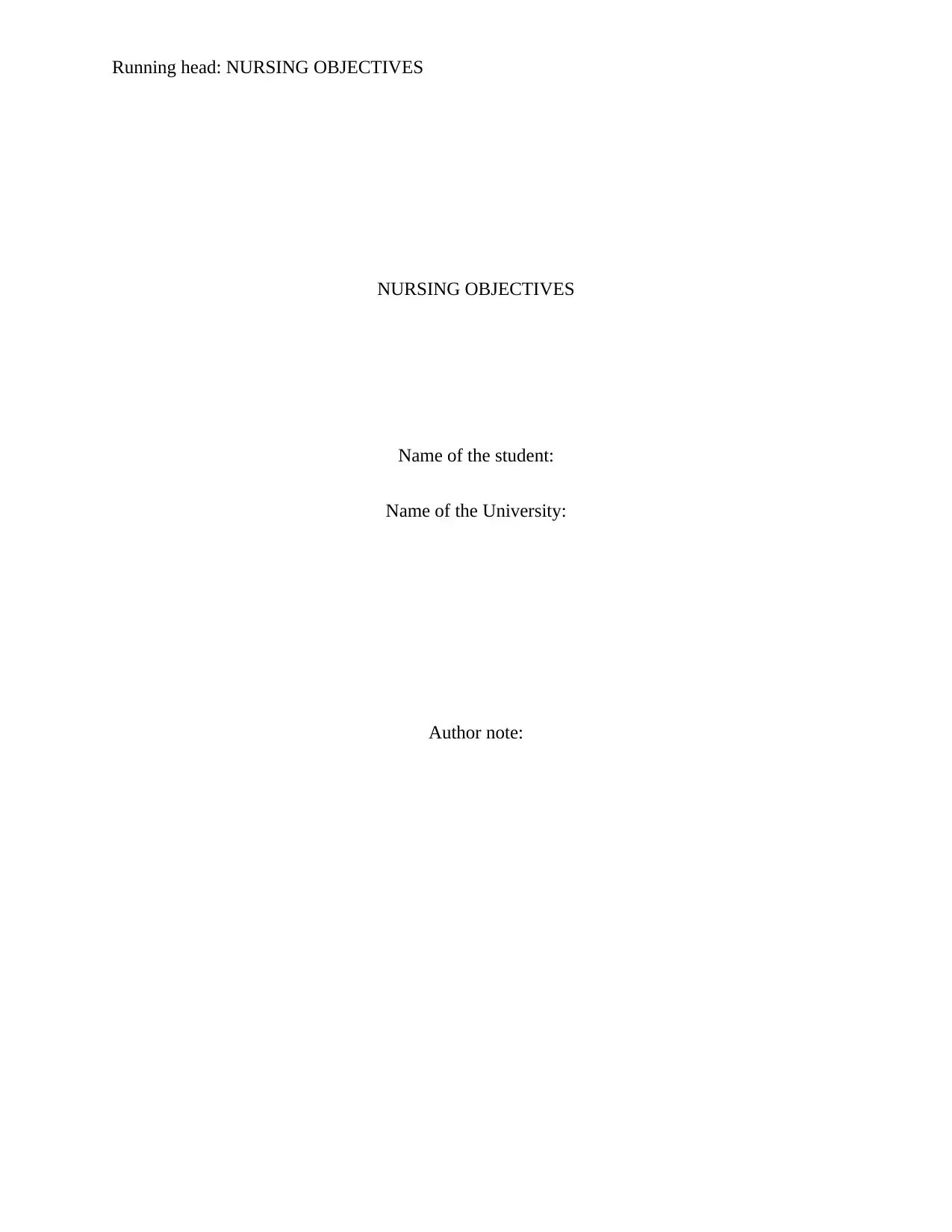
Running head: NURSING OBJECTIVES
NURSING OBJECTIVES
Name of the student:
Name of the University:
Author note:
NURSING OBJECTIVES
Name of the student:
Name of the University:
Author note:
Paraphrase This Document
Need a fresh take? Get an instant paraphrase of this document with our AI Paraphraser
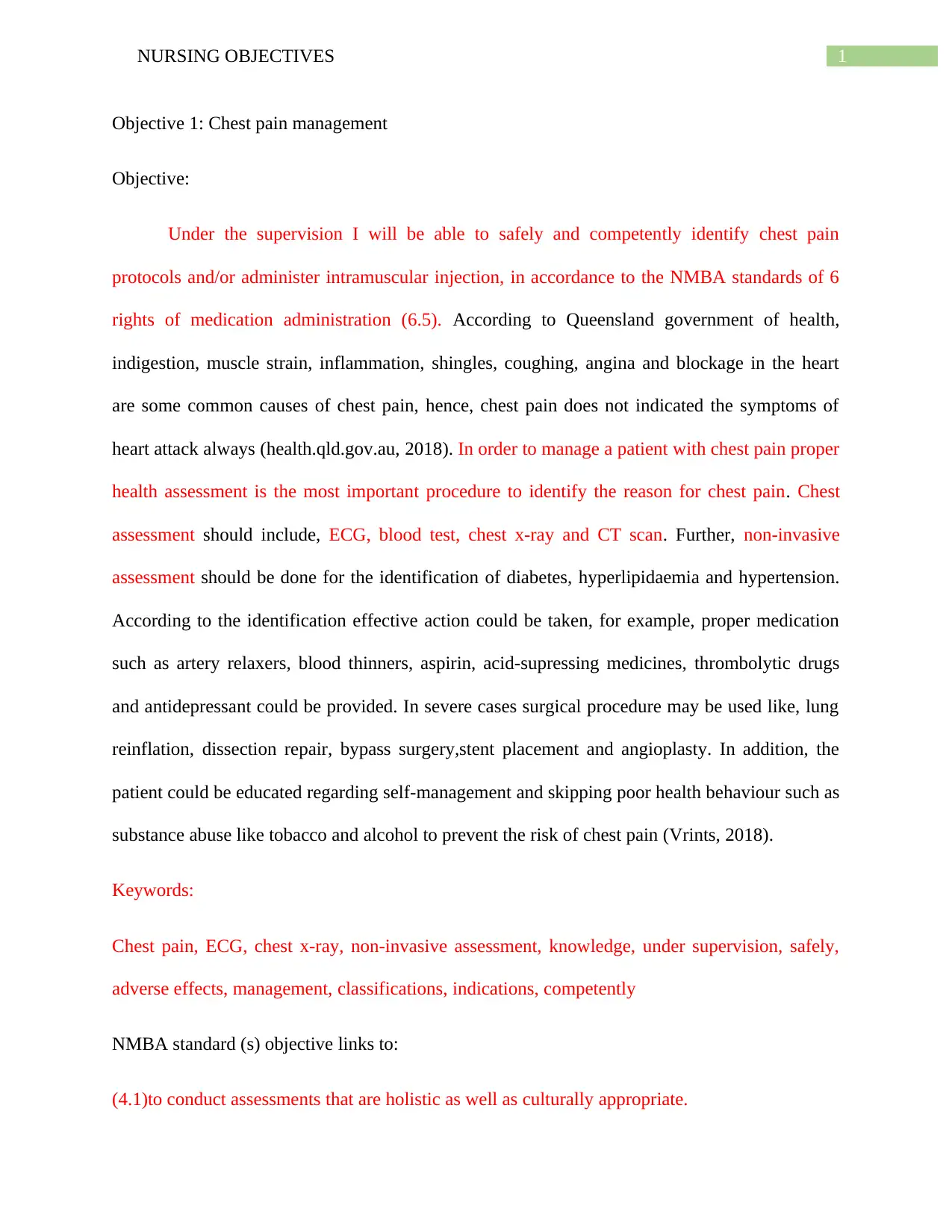
1NURSING OBJECTIVES
Objective 1: Chest pain management
Objective:
Under the supervision I will be able to safely and competently identify chest pain
protocols and/or administer intramuscular injection, in accordance to the NMBA standards of 6
rights of medication administration (6.5). According to Queensland government of health,
indigestion, muscle strain, inflammation, shingles, coughing, angina and blockage in the heart
are some common causes of chest pain, hence, chest pain does not indicated the symptoms of
heart attack always (health.qld.gov.au, 2018). In order to manage a patient with chest pain proper
health assessment is the most important procedure to identify the reason for chest pain. Chest
assessment should include, ECG, blood test, chest x-ray and CT scan. Further, non-invasive
assessment should be done for the identification of diabetes, hyperlipidaemia and hypertension.
According to the identification effective action could be taken, for example, proper medication
such as artery relaxers, blood thinners, aspirin, acid-supressing medicines, thrombolytic drugs
and antidepressant could be provided. In severe cases surgical procedure may be used like, lung
reinflation, dissection repair, bypass surgery,stent placement and angioplasty. In addition, the
patient could be educated regarding self-management and skipping poor health behaviour such as
substance abuse like tobacco and alcohol to prevent the risk of chest pain (Vrints, 2018).
Keywords:
Chest pain, ECG, chest x-ray, non-invasive assessment, knowledge, under supervision, safely,
adverse effects, management, classifications, indications, competently
NMBA standard (s) objective links to:
(4.1)to conduct assessments that are holistic as well as culturally appropriate.
Objective 1: Chest pain management
Objective:
Under the supervision I will be able to safely and competently identify chest pain
protocols and/or administer intramuscular injection, in accordance to the NMBA standards of 6
rights of medication administration (6.5). According to Queensland government of health,
indigestion, muscle strain, inflammation, shingles, coughing, angina and blockage in the heart
are some common causes of chest pain, hence, chest pain does not indicated the symptoms of
heart attack always (health.qld.gov.au, 2018). In order to manage a patient with chest pain proper
health assessment is the most important procedure to identify the reason for chest pain. Chest
assessment should include, ECG, blood test, chest x-ray and CT scan. Further, non-invasive
assessment should be done for the identification of diabetes, hyperlipidaemia and hypertension.
According to the identification effective action could be taken, for example, proper medication
such as artery relaxers, blood thinners, aspirin, acid-supressing medicines, thrombolytic drugs
and antidepressant could be provided. In severe cases surgical procedure may be used like, lung
reinflation, dissection repair, bypass surgery,stent placement and angioplasty. In addition, the
patient could be educated regarding self-management and skipping poor health behaviour such as
substance abuse like tobacco and alcohol to prevent the risk of chest pain (Vrints, 2018).
Keywords:
Chest pain, ECG, chest x-ray, non-invasive assessment, knowledge, under supervision, safely,
adverse effects, management, classifications, indications, competently
NMBA standard (s) objective links to:
(4.1)to conduct assessments that are holistic as well as culturally appropriate.
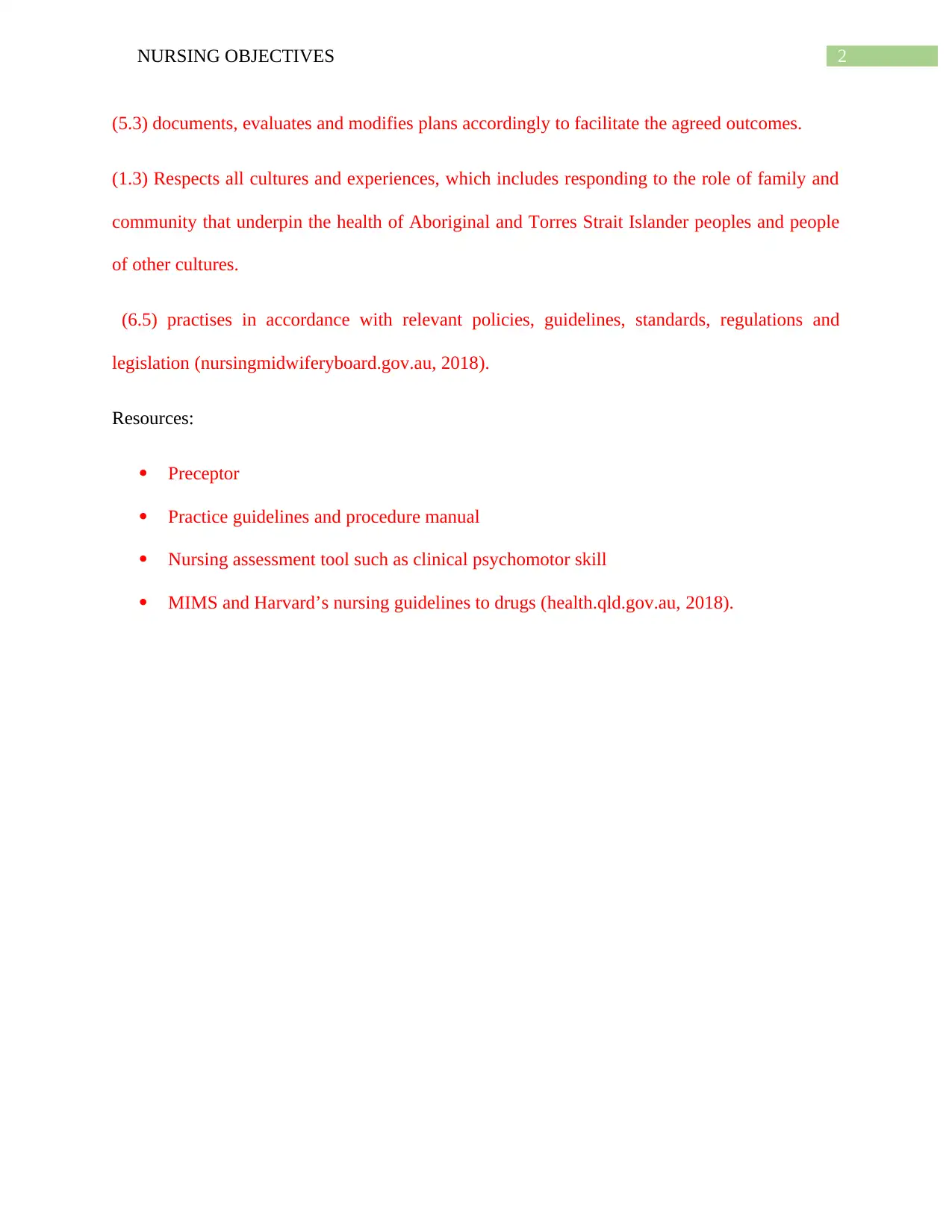
2NURSING OBJECTIVES
(5.3) documents, evaluates and modifies plans accordingly to facilitate the agreed outcomes.
(1.3) Respects all cultures and experiences, which includes responding to the role of family and
community that underpin the health of Aboriginal and Torres Strait Islander peoples and people
of other cultures.
(6.5) practises in accordance with relevant policies, guidelines, standards, regulations and
legislation (nursingmidwiferyboard.gov.au, 2018).
Resources:
Preceptor
Practice guidelines and procedure manual
Nursing assessment tool such as clinical psychomotor skill
MIMS and Harvard’s nursing guidelines to drugs (health.qld.gov.au, 2018).
(5.3) documents, evaluates and modifies plans accordingly to facilitate the agreed outcomes.
(1.3) Respects all cultures and experiences, which includes responding to the role of family and
community that underpin the health of Aboriginal and Torres Strait Islander peoples and people
of other cultures.
(6.5) practises in accordance with relevant policies, guidelines, standards, regulations and
legislation (nursingmidwiferyboard.gov.au, 2018).
Resources:
Preceptor
Practice guidelines and procedure manual
Nursing assessment tool such as clinical psychomotor skill
MIMS and Harvard’s nursing guidelines to drugs (health.qld.gov.au, 2018).
⊘ This is a preview!⊘
Do you want full access?
Subscribe today to unlock all pages.

Trusted by 1+ million students worldwide
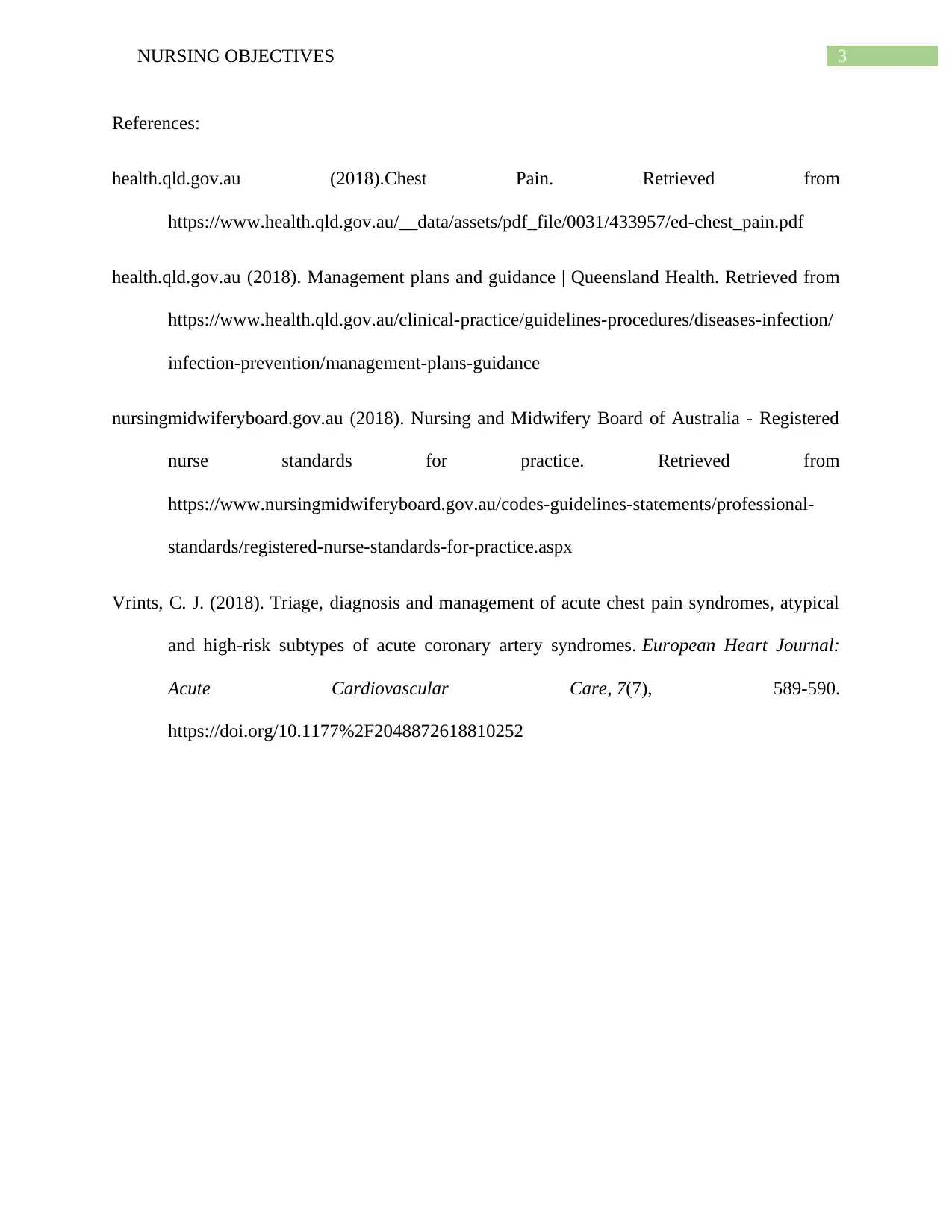
3NURSING OBJECTIVES
References:
health.qld.gov.au (2018).Chest Pain. Retrieved from
https://www.health.qld.gov.au/__data/assets/pdf_file/0031/433957/ed-chest_pain.pdf
health.qld.gov.au (2018). Management plans and guidance | Queensland Health. Retrieved from
https://www.health.qld.gov.au/clinical-practice/guidelines-procedures/diseases-infection/
infection-prevention/management-plans-guidance
nursingmidwiferyboard.gov.au (2018). Nursing and Midwifery Board of Australia - Registered
nurse standards for practice. Retrieved from
https://www.nursingmidwiferyboard.gov.au/codes-guidelines-statements/professional-
standards/registered-nurse-standards-for-practice.aspx
Vrints, C. J. (2018). Triage, diagnosis and management of acute chest pain syndromes, atypical
and high-risk subtypes of acute coronary artery syndromes. European Heart Journal:
Acute Cardiovascular Care, 7(7), 589-590.
https://doi.org/10.1177%2F2048872618810252
References:
health.qld.gov.au (2018).Chest Pain. Retrieved from
https://www.health.qld.gov.au/__data/assets/pdf_file/0031/433957/ed-chest_pain.pdf
health.qld.gov.au (2018). Management plans and guidance | Queensland Health. Retrieved from
https://www.health.qld.gov.au/clinical-practice/guidelines-procedures/diseases-infection/
infection-prevention/management-plans-guidance
nursingmidwiferyboard.gov.au (2018). Nursing and Midwifery Board of Australia - Registered
nurse standards for practice. Retrieved from
https://www.nursingmidwiferyboard.gov.au/codes-guidelines-statements/professional-
standards/registered-nurse-standards-for-practice.aspx
Vrints, C. J. (2018). Triage, diagnosis and management of acute chest pain syndromes, atypical
and high-risk subtypes of acute coronary artery syndromes. European Heart Journal:
Acute Cardiovascular Care, 7(7), 589-590.
https://doi.org/10.1177%2F2048872618810252
Paraphrase This Document
Need a fresh take? Get an instant paraphrase of this document with our AI Paraphraser
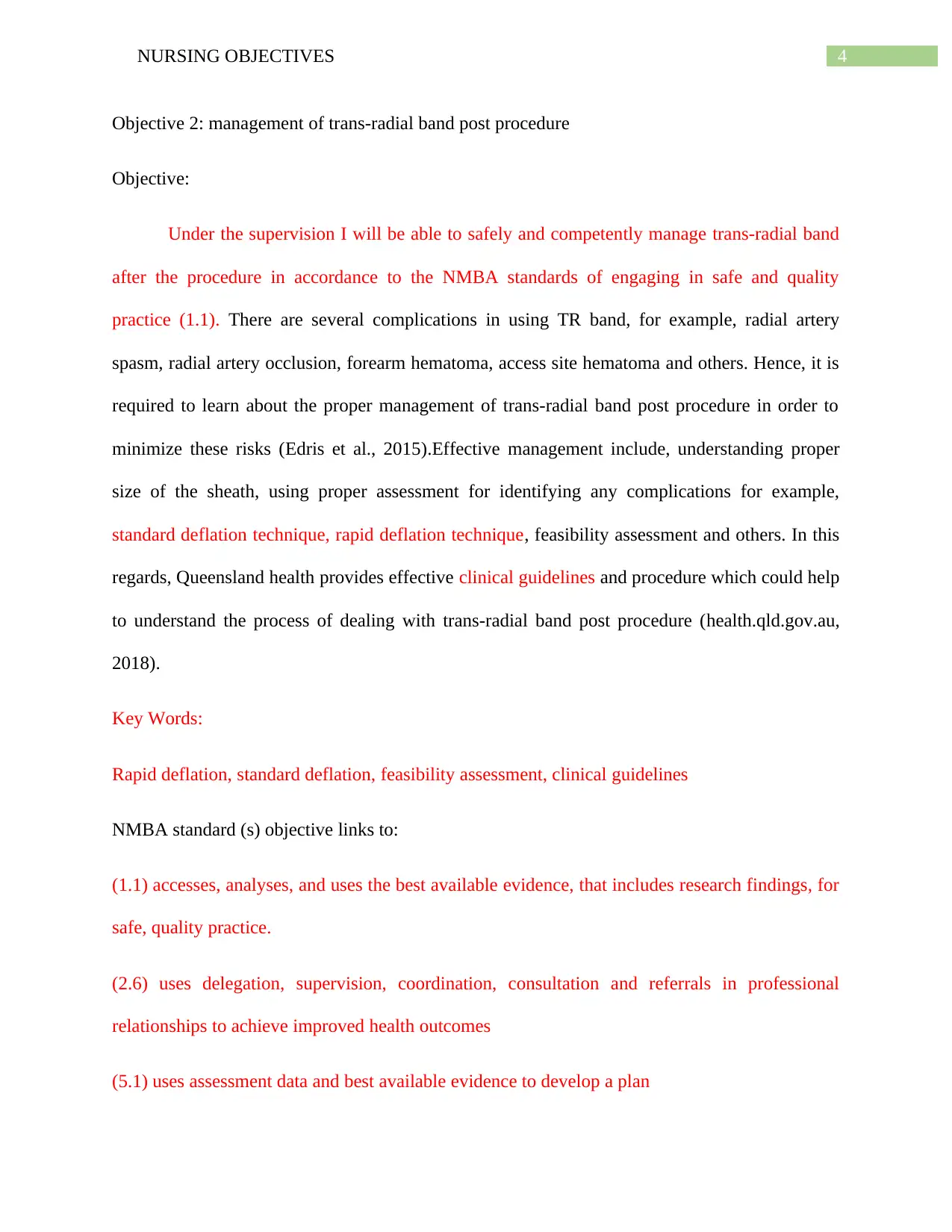
4NURSING OBJECTIVES
Objective 2: management of trans-radial band post procedure
Objective:
Under the supervision I will be able to safely and competently manage trans-radial band
after the procedure in accordance to the NMBA standards of engaging in safe and quality
practice (1.1). There are several complications in using TR band, for example, radial artery
spasm, radial artery occlusion, forearm hematoma, access site hematoma and others. Hence, it is
required to learn about the proper management of trans-radial band post procedure in order to
minimize these risks (Edris et al., 2015).Effective management include, understanding proper
size of the sheath, using proper assessment for identifying any complications for example,
standard deflation technique, rapid deflation technique, feasibility assessment and others. In this
regards, Queensland health provides effective clinical guidelines and procedure which could help
to understand the process of dealing with trans-radial band post procedure (health.qld.gov.au,
2018).
Key Words:
Rapid deflation, standard deflation, feasibility assessment, clinical guidelines
NMBA standard (s) objective links to:
(1.1) accesses, analyses, and uses the best available evidence, that includes research findings, for
safe, quality practice.
(2.6) uses delegation, supervision, coordination, consultation and referrals in professional
relationships to achieve improved health outcomes
(5.1) uses assessment data and best available evidence to develop a plan
Objective 2: management of trans-radial band post procedure
Objective:
Under the supervision I will be able to safely and competently manage trans-radial band
after the procedure in accordance to the NMBA standards of engaging in safe and quality
practice (1.1). There are several complications in using TR band, for example, radial artery
spasm, radial artery occlusion, forearm hematoma, access site hematoma and others. Hence, it is
required to learn about the proper management of trans-radial band post procedure in order to
minimize these risks (Edris et al., 2015).Effective management include, understanding proper
size of the sheath, using proper assessment for identifying any complications for example,
standard deflation technique, rapid deflation technique, feasibility assessment and others. In this
regards, Queensland health provides effective clinical guidelines and procedure which could help
to understand the process of dealing with trans-radial band post procedure (health.qld.gov.au,
2018).
Key Words:
Rapid deflation, standard deflation, feasibility assessment, clinical guidelines
NMBA standard (s) objective links to:
(1.1) accesses, analyses, and uses the best available evidence, that includes research findings, for
safe, quality practice.
(2.6) uses delegation, supervision, coordination, consultation and referrals in professional
relationships to achieve improved health outcomes
(5.1) uses assessment data and best available evidence to develop a plan
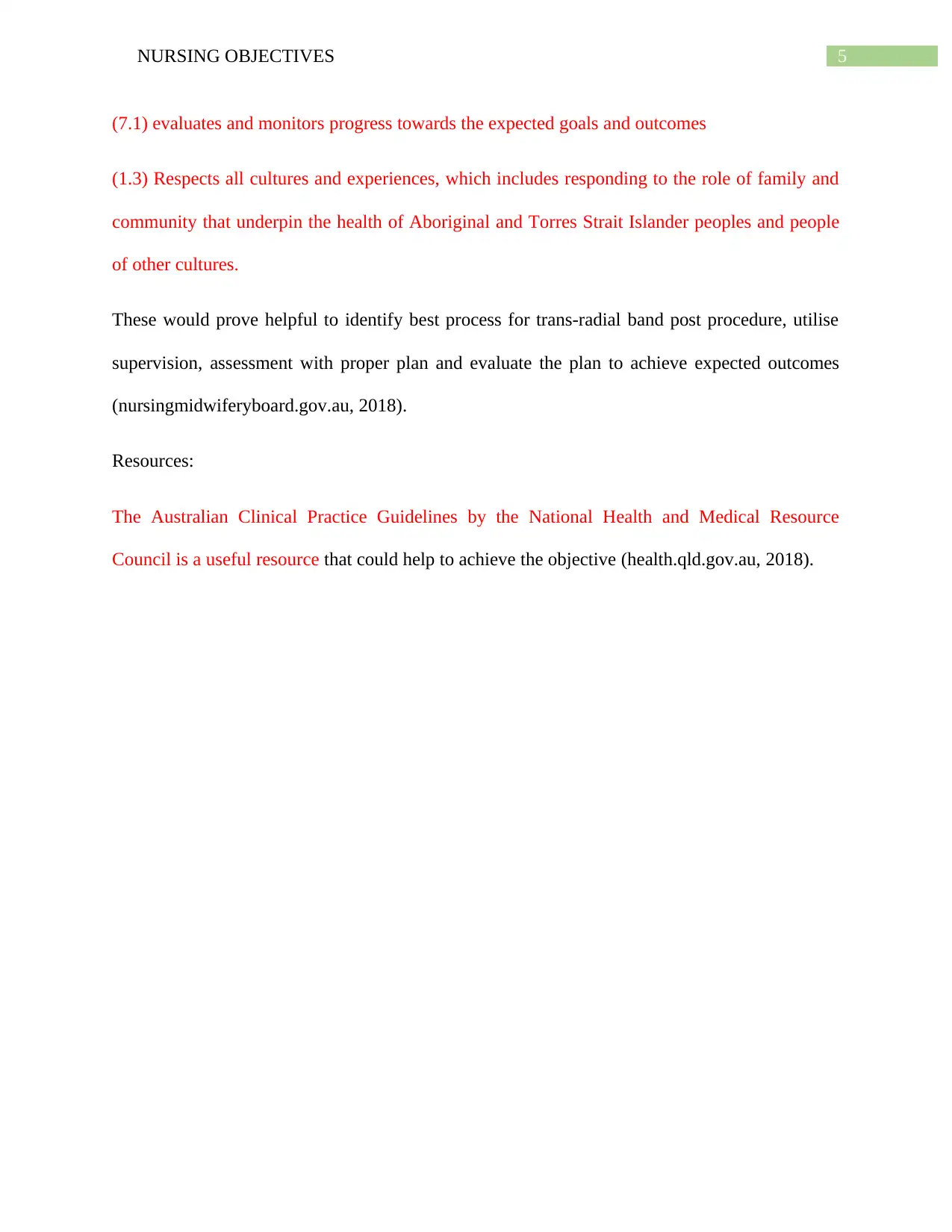
5NURSING OBJECTIVES
(7.1) evaluates and monitors progress towards the expected goals and outcomes
(1.3) Respects all cultures and experiences, which includes responding to the role of family and
community that underpin the health of Aboriginal and Torres Strait Islander peoples and people
of other cultures.
These would prove helpful to identify best process for trans-radial band post procedure, utilise
supervision, assessment with proper plan and evaluate the plan to achieve expected outcomes
(nursingmidwiferyboard.gov.au, 2018).
Resources:
The Australian Clinical Practice Guidelines by the National Health and Medical Resource
Council is a useful resource that could help to achieve the objective (health.qld.gov.au, 2018).
(7.1) evaluates and monitors progress towards the expected goals and outcomes
(1.3) Respects all cultures and experiences, which includes responding to the role of family and
community that underpin the health of Aboriginal and Torres Strait Islander peoples and people
of other cultures.
These would prove helpful to identify best process for trans-radial band post procedure, utilise
supervision, assessment with proper plan and evaluate the plan to achieve expected outcomes
(nursingmidwiferyboard.gov.au, 2018).
Resources:
The Australian Clinical Practice Guidelines by the National Health and Medical Resource
Council is a useful resource that could help to achieve the objective (health.qld.gov.au, 2018).
⊘ This is a preview!⊘
Do you want full access?
Subscribe today to unlock all pages.

Trusted by 1+ million students worldwide
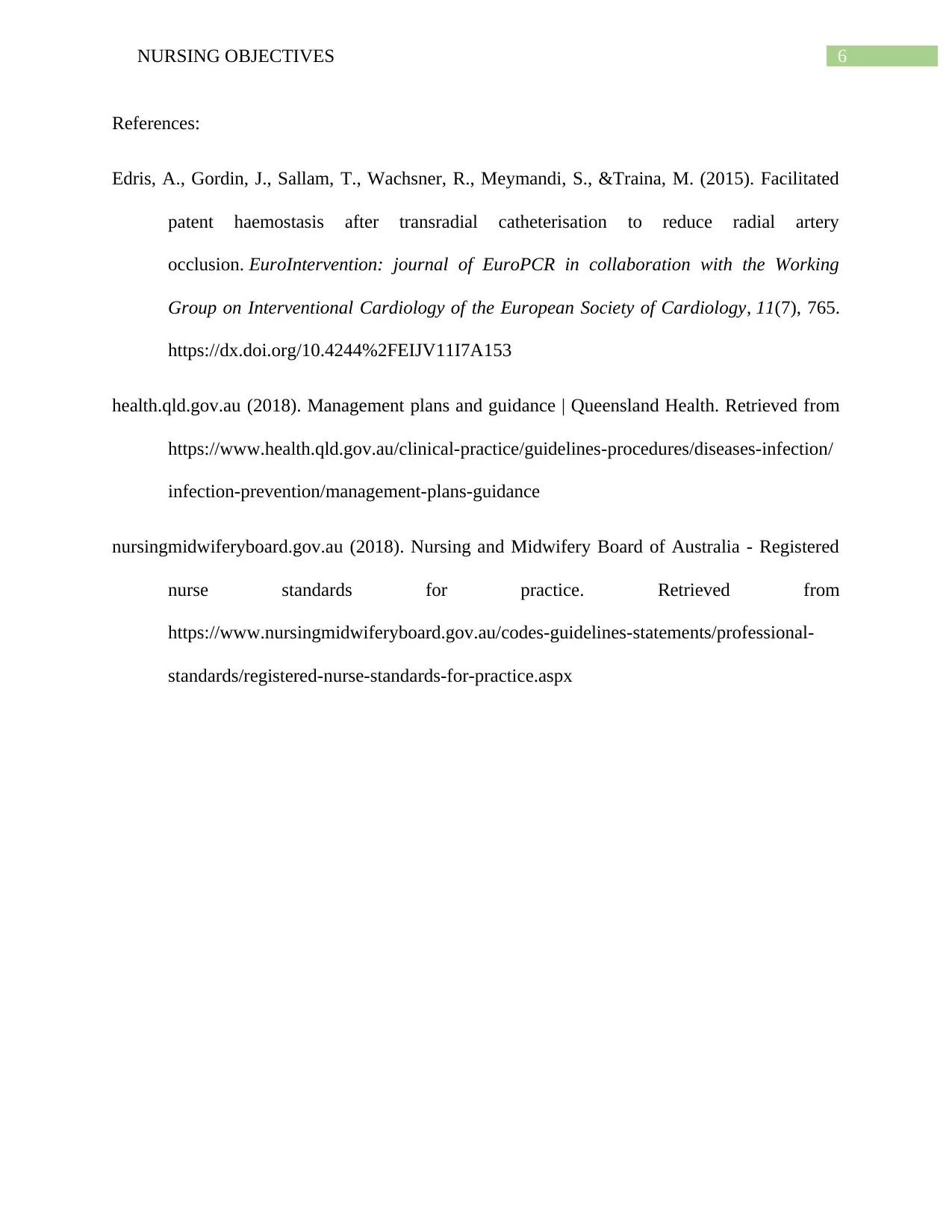
6NURSING OBJECTIVES
References:
Edris, A., Gordin, J., Sallam, T., Wachsner, R., Meymandi, S., &Traina, M. (2015). Facilitated
patent haemostasis after transradial catheterisation to reduce radial artery
occlusion. EuroIntervention: journal of EuroPCR in collaboration with the Working
Group on Interventional Cardiology of the European Society of Cardiology, 11(7), 765.
https://dx.doi.org/10.4244%2FEIJV11I7A153
health.qld.gov.au (2018). Management plans and guidance | Queensland Health. Retrieved from
https://www.health.qld.gov.au/clinical-practice/guidelines-procedures/diseases-infection/
infection-prevention/management-plans-guidance
nursingmidwiferyboard.gov.au (2018). Nursing and Midwifery Board of Australia - Registered
nurse standards for practice. Retrieved from
https://www.nursingmidwiferyboard.gov.au/codes-guidelines-statements/professional-
standards/registered-nurse-standards-for-practice.aspx
References:
Edris, A., Gordin, J., Sallam, T., Wachsner, R., Meymandi, S., &Traina, M. (2015). Facilitated
patent haemostasis after transradial catheterisation to reduce radial artery
occlusion. EuroIntervention: journal of EuroPCR in collaboration with the Working
Group on Interventional Cardiology of the European Society of Cardiology, 11(7), 765.
https://dx.doi.org/10.4244%2FEIJV11I7A153
health.qld.gov.au (2018). Management plans and guidance | Queensland Health. Retrieved from
https://www.health.qld.gov.au/clinical-practice/guidelines-procedures/diseases-infection/
infection-prevention/management-plans-guidance
nursingmidwiferyboard.gov.au (2018). Nursing and Midwifery Board of Australia - Registered
nurse standards for practice. Retrieved from
https://www.nursingmidwiferyboard.gov.au/codes-guidelines-statements/professional-
standards/registered-nurse-standards-for-practice.aspx
Paraphrase This Document
Need a fresh take? Get an instant paraphrase of this document with our AI Paraphraser
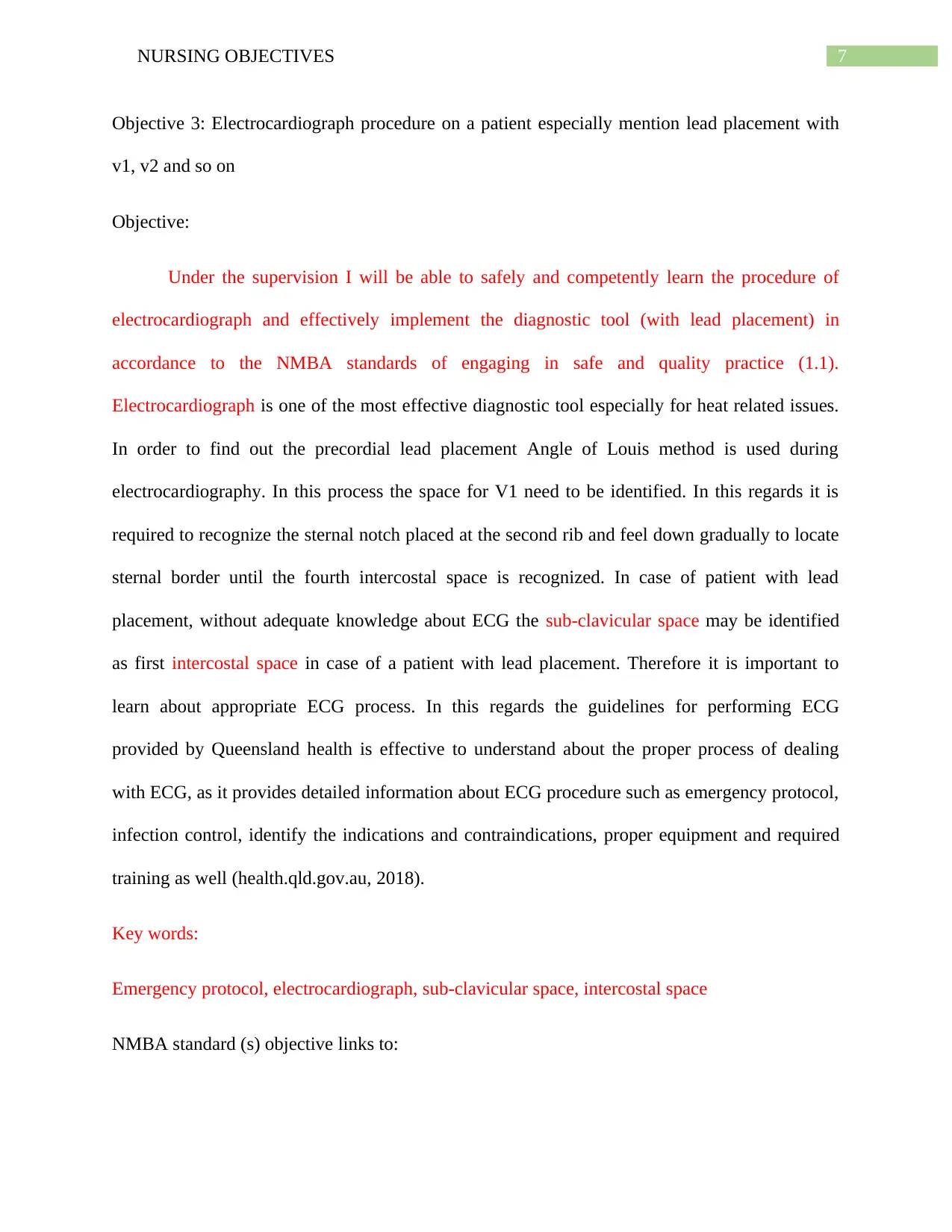
7NURSING OBJECTIVES
Objective 3: Electrocardiograph procedure on a patient especially mention lead placement with
v1, v2 and so on
Objective:
Under the supervision I will be able to safely and competently learn the procedure of
electrocardiograph and effectively implement the diagnostic tool (with lead placement) in
accordance to the NMBA standards of engaging in safe and quality practice (1.1).
Electrocardiograph is one of the most effective diagnostic tool especially for heat related issues.
In order to find out the precordial lead placement Angle of Louis method is used during
electrocardiography. In this process the space for V1 need to be identified. In this regards it is
required to recognize the sternal notch placed at the second rib and feel down gradually to locate
sternal border until the fourth intercostal space is recognized. In case of patient with lead
placement, without adequate knowledge about ECG the sub-clavicular space may be identified
as first intercostal space in case of a patient with lead placement. Therefore it is important to
learn about appropriate ECG process. In this regards the guidelines for performing ECG
provided by Queensland health is effective to understand about the proper process of dealing
with ECG, as it provides detailed information about ECG procedure such as emergency protocol,
infection control, identify the indications and contraindications, proper equipment and required
training as well (health.qld.gov.au, 2018).
Key words:
Emergency protocol, electrocardiograph, sub-clavicular space, intercostal space
NMBA standard (s) objective links to:
Objective 3: Electrocardiograph procedure on a patient especially mention lead placement with
v1, v2 and so on
Objective:
Under the supervision I will be able to safely and competently learn the procedure of
electrocardiograph and effectively implement the diagnostic tool (with lead placement) in
accordance to the NMBA standards of engaging in safe and quality practice (1.1).
Electrocardiograph is one of the most effective diagnostic tool especially for heat related issues.
In order to find out the precordial lead placement Angle of Louis method is used during
electrocardiography. In this process the space for V1 need to be identified. In this regards it is
required to recognize the sternal notch placed at the second rib and feel down gradually to locate
sternal border until the fourth intercostal space is recognized. In case of patient with lead
placement, without adequate knowledge about ECG the sub-clavicular space may be identified
as first intercostal space in case of a patient with lead placement. Therefore it is important to
learn about appropriate ECG process. In this regards the guidelines for performing ECG
provided by Queensland health is effective to understand about the proper process of dealing
with ECG, as it provides detailed information about ECG procedure such as emergency protocol,
infection control, identify the indications and contraindications, proper equipment and required
training as well (health.qld.gov.au, 2018).
Key words:
Emergency protocol, electrocardiograph, sub-clavicular space, intercostal space
NMBA standard (s) objective links to:
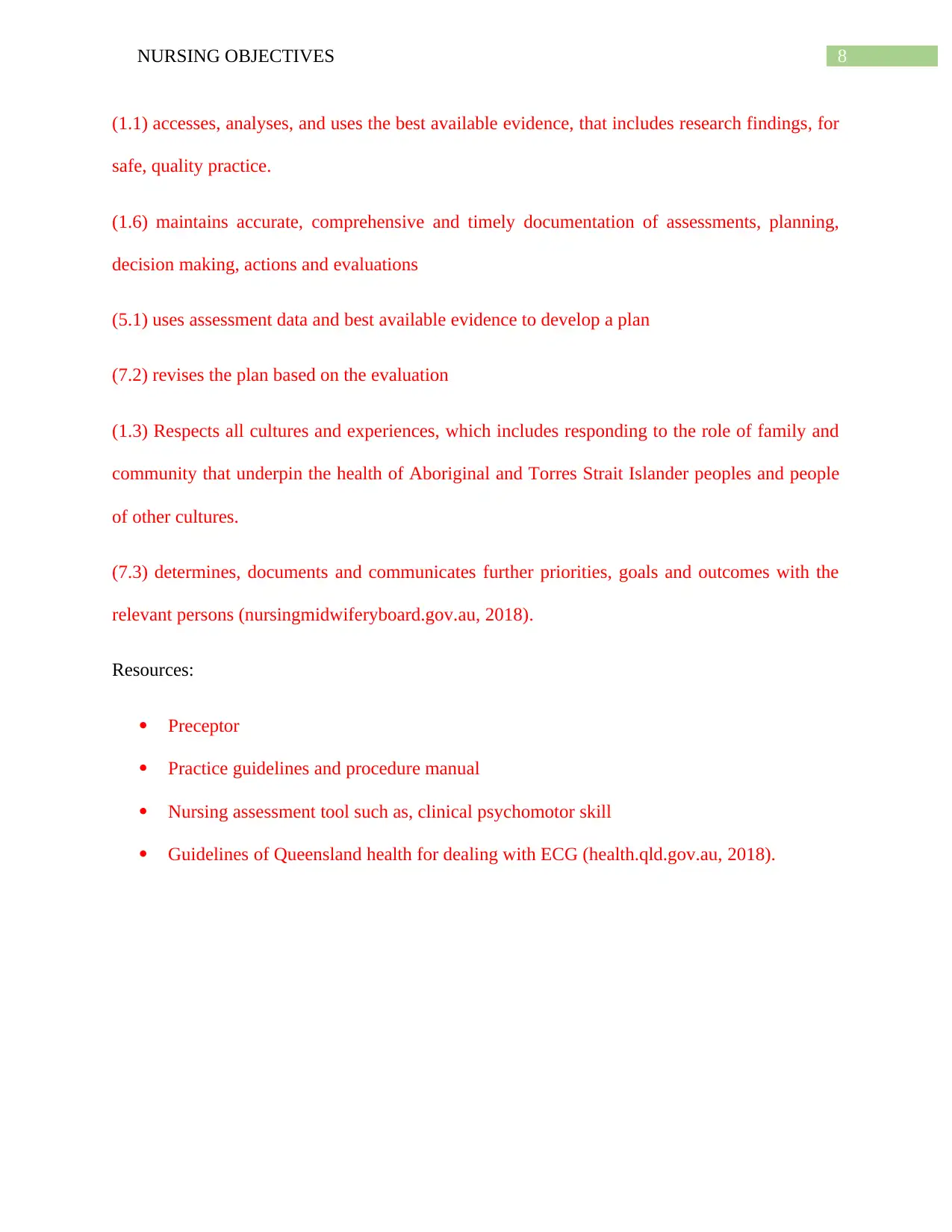
8NURSING OBJECTIVES
(1.1) accesses, analyses, and uses the best available evidence, that includes research findings, for
safe, quality practice.
(1.6) maintains accurate, comprehensive and timely documentation of assessments, planning,
decision making, actions and evaluations
(5.1) uses assessment data and best available evidence to develop a plan
(7.2) revises the plan based on the evaluation
(1.3) Respects all cultures and experiences, which includes responding to the role of family and
community that underpin the health of Aboriginal and Torres Strait Islander peoples and people
of other cultures.
(7.3) determines, documents and communicates further priorities, goals and outcomes with the
relevant persons (nursingmidwiferyboard.gov.au, 2018).
Resources:
Preceptor
Practice guidelines and procedure manual
Nursing assessment tool such as, clinical psychomotor skill
Guidelines of Queensland health for dealing with ECG (health.qld.gov.au, 2018).
(1.1) accesses, analyses, and uses the best available evidence, that includes research findings, for
safe, quality practice.
(1.6) maintains accurate, comprehensive and timely documentation of assessments, planning,
decision making, actions and evaluations
(5.1) uses assessment data and best available evidence to develop a plan
(7.2) revises the plan based on the evaluation
(1.3) Respects all cultures and experiences, which includes responding to the role of family and
community that underpin the health of Aboriginal and Torres Strait Islander peoples and people
of other cultures.
(7.3) determines, documents and communicates further priorities, goals and outcomes with the
relevant persons (nursingmidwiferyboard.gov.au, 2018).
Resources:
Preceptor
Practice guidelines and procedure manual
Nursing assessment tool such as, clinical psychomotor skill
Guidelines of Queensland health for dealing with ECG (health.qld.gov.au, 2018).
⊘ This is a preview!⊘
Do you want full access?
Subscribe today to unlock all pages.

Trusted by 1+ million students worldwide
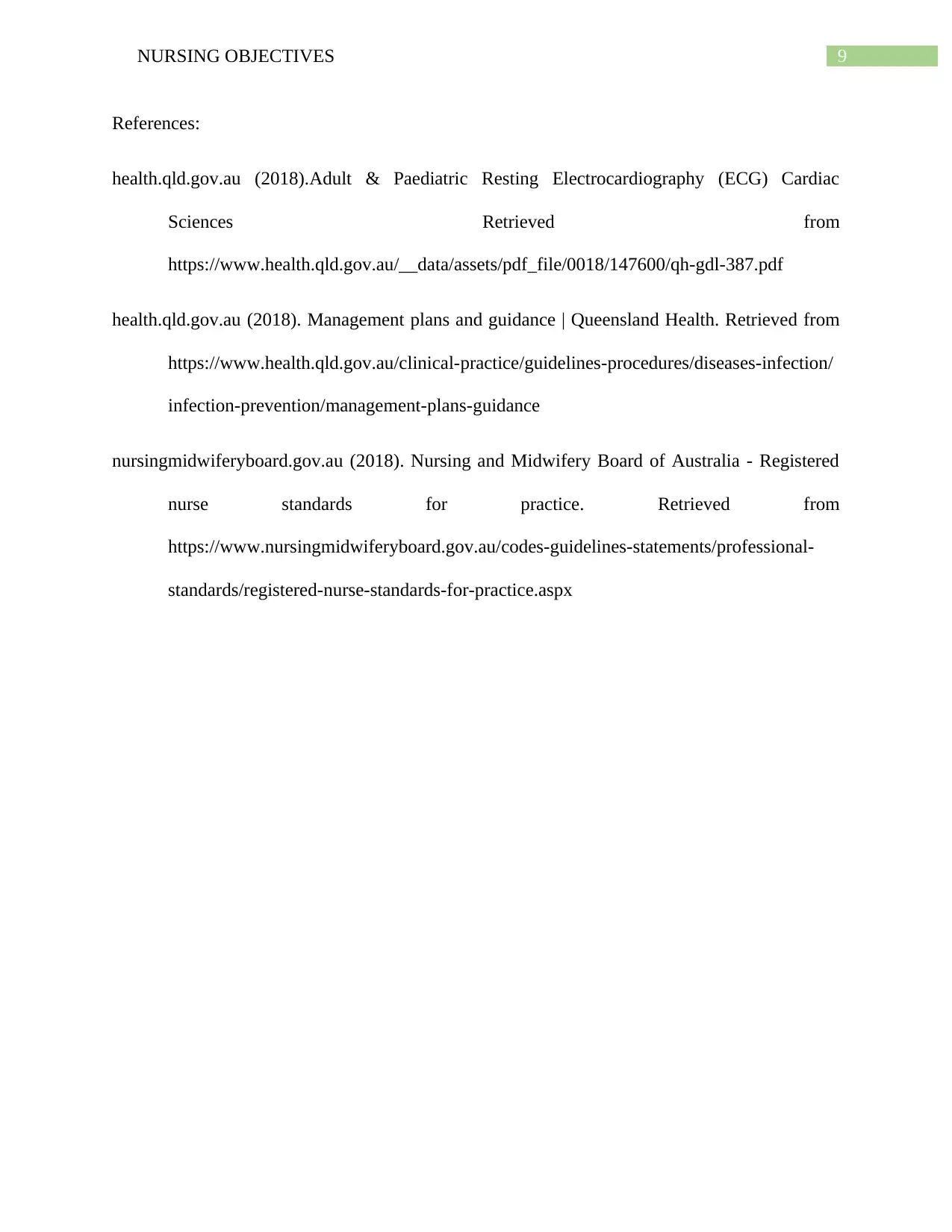
9NURSING OBJECTIVES
References:
health.qld.gov.au (2018).Adult & Paediatric Resting Electrocardiography (ECG) Cardiac
Sciences Retrieved from
https://www.health.qld.gov.au/__data/assets/pdf_file/0018/147600/qh-gdl-387.pdf
health.qld.gov.au (2018). Management plans and guidance | Queensland Health. Retrieved from
https://www.health.qld.gov.au/clinical-practice/guidelines-procedures/diseases-infection/
infection-prevention/management-plans-guidance
nursingmidwiferyboard.gov.au (2018). Nursing and Midwifery Board of Australia - Registered
nurse standards for practice. Retrieved from
https://www.nursingmidwiferyboard.gov.au/codes-guidelines-statements/professional-
standards/registered-nurse-standards-for-practice.aspx
References:
health.qld.gov.au (2018).Adult & Paediatric Resting Electrocardiography (ECG) Cardiac
Sciences Retrieved from
https://www.health.qld.gov.au/__data/assets/pdf_file/0018/147600/qh-gdl-387.pdf
health.qld.gov.au (2018). Management plans and guidance | Queensland Health. Retrieved from
https://www.health.qld.gov.au/clinical-practice/guidelines-procedures/diseases-infection/
infection-prevention/management-plans-guidance
nursingmidwiferyboard.gov.au (2018). Nursing and Midwifery Board of Australia - Registered
nurse standards for practice. Retrieved from
https://www.nursingmidwiferyboard.gov.au/codes-guidelines-statements/professional-
standards/registered-nurse-standards-for-practice.aspx
Paraphrase This Document
Need a fresh take? Get an instant paraphrase of this document with our AI Paraphraser
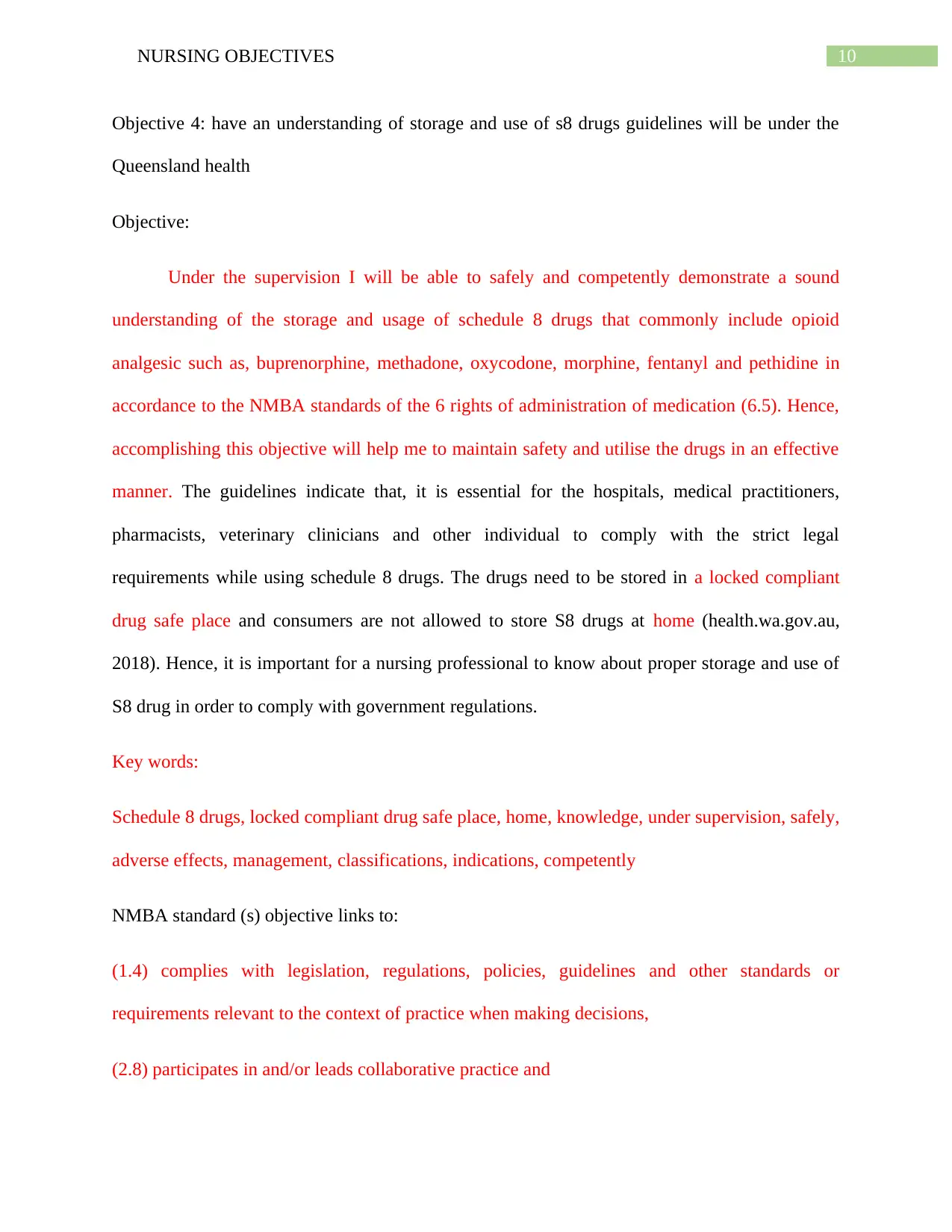
10NURSING OBJECTIVES
Objective 4: have an understanding of storage and use of s8 drugs guidelines will be under the
Queensland health
Objective:
Under the supervision I will be able to safely and competently demonstrate a sound
understanding of the storage and usage of schedule 8 drugs that commonly include opioid
analgesic such as, buprenorphine, methadone, oxycodone, morphine, fentanyl and pethidine in
accordance to the NMBA standards of the 6 rights of administration of medication (6.5). Hence,
accomplishing this objective will help me to maintain safety and utilise the drugs in an effective
manner. The guidelines indicate that, it is essential for the hospitals, medical practitioners,
pharmacists, veterinary clinicians and other individual to comply with the strict legal
requirements while using schedule 8 drugs. The drugs need to be stored in a locked compliant
drug safe place and consumers are not allowed to store S8 drugs at home (health.wa.gov.au,
2018). Hence, it is important for a nursing professional to know about proper storage and use of
S8 drug in order to comply with government regulations.
Key words:
Schedule 8 drugs, locked compliant drug safe place, home, knowledge, under supervision, safely,
adverse effects, management, classifications, indications, competently
NMBA standard (s) objective links to:
(1.4) complies with legislation, regulations, policies, guidelines and other standards or
requirements relevant to the context of practice when making decisions,
(2.8) participates in and/or leads collaborative practice and
Objective 4: have an understanding of storage and use of s8 drugs guidelines will be under the
Queensland health
Objective:
Under the supervision I will be able to safely and competently demonstrate a sound
understanding of the storage and usage of schedule 8 drugs that commonly include opioid
analgesic such as, buprenorphine, methadone, oxycodone, morphine, fentanyl and pethidine in
accordance to the NMBA standards of the 6 rights of administration of medication (6.5). Hence,
accomplishing this objective will help me to maintain safety and utilise the drugs in an effective
manner. The guidelines indicate that, it is essential for the hospitals, medical practitioners,
pharmacists, veterinary clinicians and other individual to comply with the strict legal
requirements while using schedule 8 drugs. The drugs need to be stored in a locked compliant
drug safe place and consumers are not allowed to store S8 drugs at home (health.wa.gov.au,
2018). Hence, it is important for a nursing professional to know about proper storage and use of
S8 drug in order to comply with government regulations.
Key words:
Schedule 8 drugs, locked compliant drug safe place, home, knowledge, under supervision, safely,
adverse effects, management, classifications, indications, competently
NMBA standard (s) objective links to:
(1.4) complies with legislation, regulations, policies, guidelines and other standards or
requirements relevant to the context of practice when making decisions,
(2.8) participates in and/or leads collaborative practice and
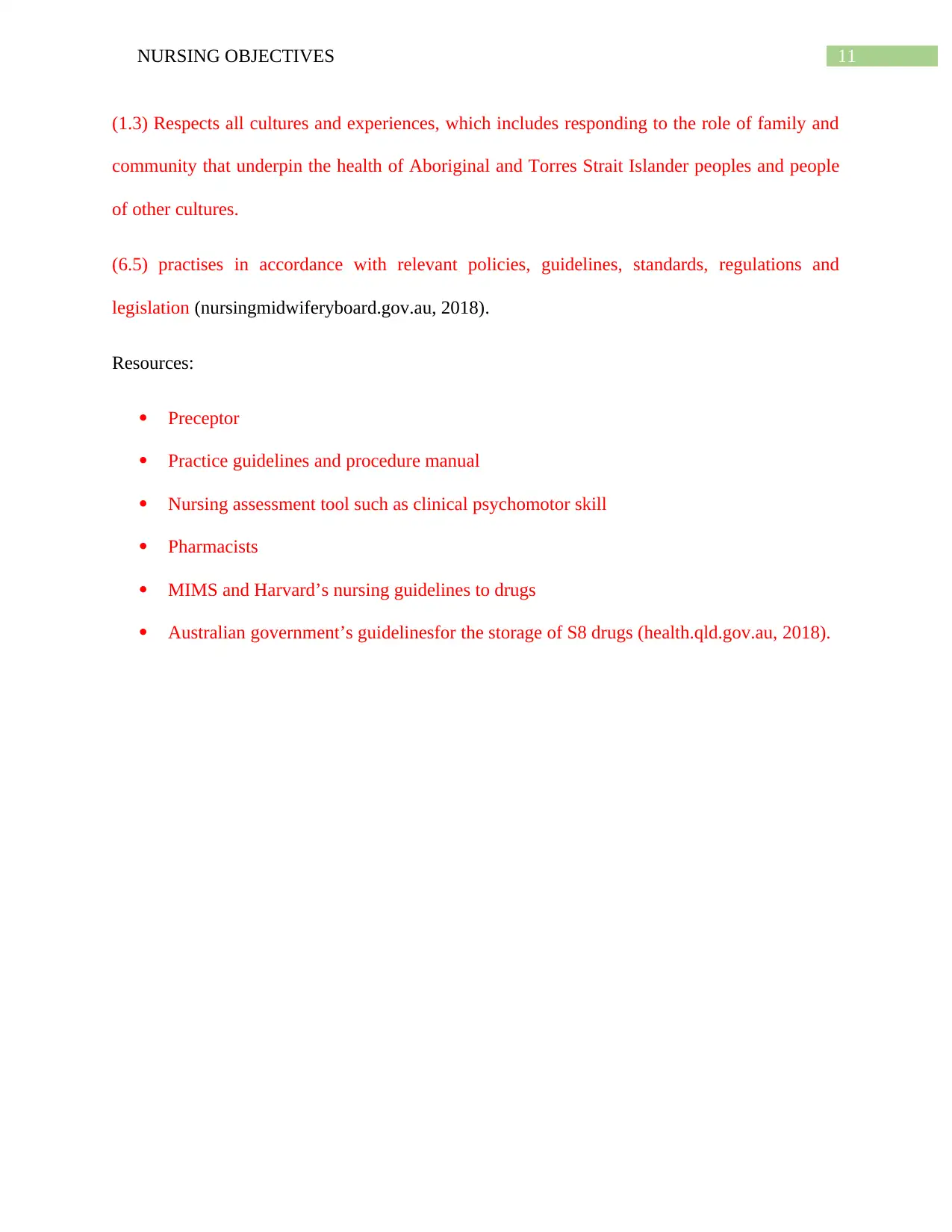
11NURSING OBJECTIVES
(1.3) Respects all cultures and experiences, which includes responding to the role of family and
community that underpin the health of Aboriginal and Torres Strait Islander peoples and people
of other cultures.
(6.5) practises in accordance with relevant policies, guidelines, standards, regulations and
legislation (nursingmidwiferyboard.gov.au, 2018).
Resources:
Preceptor
Practice guidelines and procedure manual
Nursing assessment tool such as clinical psychomotor skill
Pharmacists
MIMS and Harvard’s nursing guidelines to drugs
Australian government’s guidelinesfor the storage of S8 drugs (health.qld.gov.au, 2018).
(1.3) Respects all cultures and experiences, which includes responding to the role of family and
community that underpin the health of Aboriginal and Torres Strait Islander peoples and people
of other cultures.
(6.5) practises in accordance with relevant policies, guidelines, standards, regulations and
legislation (nursingmidwiferyboard.gov.au, 2018).
Resources:
Preceptor
Practice guidelines and procedure manual
Nursing assessment tool such as clinical psychomotor skill
Pharmacists
MIMS and Harvard’s nursing guidelines to drugs
Australian government’s guidelinesfor the storage of S8 drugs (health.qld.gov.au, 2018).
⊘ This is a preview!⊘
Do you want full access?
Subscribe today to unlock all pages.

Trusted by 1+ million students worldwide
1 out of 13
Related Documents
Your All-in-One AI-Powered Toolkit for Academic Success.
+13062052269
info@desklib.com
Available 24*7 on WhatsApp / Email
![[object Object]](/_next/static/media/star-bottom.7253800d.svg)
Unlock your academic potential
Copyright © 2020–2025 A2Z Services. All Rights Reserved. Developed and managed by ZUCOL.





